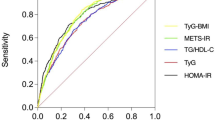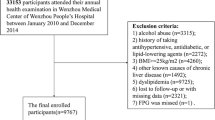Abstract
Objective
Insulin resistance (IR) is a key factor involved in the development and progression of nonalcoholic fatty liver disease (NAFLD). However, the prevalence of IR in NAFLD patients and its risk factors have been rarely reported, especially in China. This prospective study was undertaken to clarify these issues in the Chinese population.
Methods
A total of 600 NAFLD patients and 300 age- and sex-matched healthy controls were recruited between January 1, 2011, and December 31, 2013. Demographic information and clinical characteristics were collected, and the presence of IR was evaluated using the homeostasis model. Uni- and multivariate analyses were conducted, and receiver operating characteristic (ROC) curves were generated to identify IR predictors.
Results
NAFLD patients had a much higher prevalence of IR than healthy controls (37.8 vs. 2.3 %, P < 0.001). The rates of elevated alanine transferase (ALT) and aspartate transferase (AST) levels were much higher in NAFLD patients with IR than those without (53.7 vs. 41.6 % and 28.6 vs. 18.2 %, respectively, P < 0.001). Uni- and multivariate analyses revealed that female sex, general obesity, abdominal obesity, and hypertension were independent predictors for IR. The area under the ROC curve for fasting plasma insulin (FPI) detecting IR was 0.93 (P < 0.001), and the optimal cutoff was 11.3 μU/ml (sensitivity = 0.86, specificity = 0.92).
Conclusion
Chinese NAFLD patients are susceptible to IR. Female sex, general and abdominal obesity, and hypertension were independent predictors for IR in NAFLD patients. FPI is an optimal predictor for IR.

Similar content being viewed by others
References
Cohen JC, Horton JD, et al. Human fatty liver disease: old questions and new insights. Science. 2011;332:1519–1523.
Wright JH, Johnson MM, et al. Paracrine activation of hepatic stellate cells in platelet-derived growth factor C transgenic mice: evidence for stromal induction of hepatocellular carcinoma. Int J Cancer. 2014;134:778–788.
Farrell GC, Wong VW, et al. NAFLD in Asia–as common and important as in the West. Nat Rev Gastroenterol Hepatol. 2013;10:307–318.
Day CP, James OF. Steatohepatitis: a tale of two “hits”? Gastroenterology. 1998;114:842–845.
Fan JG, Saibara T, et al. What are the risk factors and settings for non-alcoholicfatty liver disease in Asia–Pacific? J Gastroenterol Hepatol. 2007;22:794–800.
DeFronzo RA, Tobin JD, et al. Glucose clamp technique: a method for quantifying insulin secretion and resistance. Am J Physiol. 1979;237:E214–E223.
Bonora E, Saggiani F, et al. Homeostasis model assessment closely mirrors the glucose clamp technique in the assessment of insulin sensitivity—studies in subjects with various degrees of glucose tolerance and insulin sensitivity. Diabetes Care. 2000;23:57–63.
Galvin P, Ward G, et al. A simple method for quantitation of insulin sensitivity and insulin release from an intravenous glucose tolerance test. Diabet Med. 1992;9:921–928.
Fan JG, Jia JD, et al. Guidelines for the diagnosis and management of nonalcoholic fatty liver disease: update 2010: (published in Chinese on Chinese Journal of Hepatology 2010; 18:163–166). J Dig Dis. 2011;12:38–44.
Grundy SM, Cleeman JI, et al. Diagnosis and management of the metabolic syndrome—an American Heart Association/National Heart, Lung, and Blood Institute Scientific Statement. Circulation. 2005;112:2735–2752.
Greenland P, Alpert JS, et al. 2010 ACCF/AHA guideline for assessment of cardiovascular risk in asymptomatic adults: executive summary: a report of the American College of Cardiology Foundation/American Heart Association Task Force on Practice Guidelines. Circulation. 2010;122:2748–2764.
Khanna D, Fitzgerald JD, Khanna PP et al. 2012 American College of Rheumatology guidelines for management of gout. Part 1: systematic nonpharmacologic and pharmacologic therapeutic approaches to hyperuricemia. Arthritis Care Res (Hoboken). 2012; 64:1431–1446.
McAuley KA, Williams SM, et al. Diagnosing insulin resistance in the general population. Diabetes Care. 2001;24:460–464.
Howard G, Bergman R, et al. Ability of alternative indices of insulin sensitivity to predict cardiovascular risk: comparison with the “minimal model”. Insulin Resistance Atherosclerosis Study (IRAS) Investigators. Ann Epidemiol. 1998;8:358–369.
Simarro Rueda M, Carbayo Herencia JA, Orozco JM et al. Association of insulin resistance to different anthropometric measures and cardiovascular risk factors in a non-diabetic population. Endocrinol Nutr. 2011;58:464–471.
Kim SH, Reaven G. Sex differences in insulin resistance and cardiovascular disease risk. J Clin Endocr Metab. 2013;98:E1716–E1721.
Chen S, Chen Y, et al. Insulin resistance and metabolic syndrome in normal-weight individuals. Endocrine. 2014;46:496–504.
Chiang JK, Lai NS, et al. Predicting insulin resistance using the triglyceride-to-high-density lipoprotein cholesterol ratio in Taiwanese adults. Cardiovasc Diabetol. 2011;10:93.
Bugianesi E, Gastaldelli A, et al. Insulin resistance in non-diabetic patients with non-alcoholic fatty liver disease: sites and mechanisms. Diabetologia. 2005;48:634–642.
Kumar R, Rastogi A, et al. Clinicopathological characteristics and metabolic profiles of non-alcoholic fatty liver disease in Indian patients with normal body mass index: do they differ from obese or overweight non-alcoholic fatty liver disease? Indian J Endocrinol Metab. 2013;17:665–671.
Okita K, Iwahashi H, et al. Homeostasis model assessment of insulin resistance for evaluating insulin sensitivity in patients with type 2 diabetes on insulin therapy. Endocr J. 2013;60:283–290.
Succurro E, Marini MA, et al. Insulin secretion in metabolically obese, but normal weight, and in metabolically healthy but obese individuals. Obesity. 2008;16:1881–1886.
Akande TO, Adeleye JO, et al. Insulin resistance in Nigerians with essential hypertension. Afr Health Sci. 2013;13:655–660.
Petersen KF, Dufour S, et al. Increased prevalence of insulin resistance and nonalcoholic fatty liver disease in Asian-Indian men. Proc Natl Acad Sci USA. 2006;103:18273–18277.
Jiang B, Liu Y, et al. Association of four insulin resistance genes with type 2 diabetes mellitus and hypertension in the Chinese Han population. Mol Biol Rep. 2014;41:925–933.
Karrowni W, Li Y, et al. Insulin resistance is associated with significant clinical atherosclerosis in nondiabetic patients with acute myocardial infarction. Arterioscl Throm Vas. 2013;33:2245–2251.
Negami M, Takahashi E, et al. Prediction of homeostasis model assessment of insulin resistance in Japanese subjects. Tokai J Exp Clin Med. 2012;37:102–106.
Hrnciar J, Avdicova M, et al. Prevalence of metabolic syndrome, insulin resistance, and microvascular angina pectoris in 500 consecutive patients referred to coronarography. Endocr Regul. 2013;47:33–38.
Peng YS, Chiu YL, et al. Decreased high-density lipoprotein cholesterol is associated with inflammation and insulin resistance in non-diabetic haemodialysis patients. Nephrology. 2010;15:692–699.
Boon J, Hoy AJ, et al. Ceramides contained in LDL are elevated in type 2 diabetes and promote inflammation and skeletal muscle insulin resistance. Diabetes. 2013;62:401–410.
Ying X, Qian Y, et al. Association of the apolipoprotein B/apolipoprotein A-I ratio and low-density lipoprotein cholesterol with insulin resistance in a Chinese population with abdominal obesity. Acta Diabetol. 2012;49:465–472.
Sung KC, Lim S, et al. Hyperinsulinemia and homeostasis model assessment of insulin resistance as predictors of hypertension: a 5-year follow-up study of Korean sample. Am J Hypertens. 2011;24:1041–1045.
Jornayvaz FR, Shulman GI. Diacylglycerol activation of protein kinase Cepsilon and hepatic insulin resistance. Cell Metab. 2012;15:574–584.
Magkos F, Su X, et al. Intrahepatic diacylglycerol content is associated with hepatic insulin resistance in obese subjects. Gastroenterology. 2012;142:1444–14446.
Uetani E, Tabara Y, et al. Liver enzyme and adipocytokine profiles are synergistically associated with insulin resistance: the J-SHIPP Study. J Atheroscler Thromb. 2012;19:577–584.
Ghamar-Chehreh ME, Amini M, et al. Elevated alanine aminotransferase activity is not associated with dyslipidemias, but related to insulin resistance and higher disease grades in non-diabetic non-alcoholic fatty liver disease. Asian Pac J Trop Biomed. 2012;2:702–706.
Kawamoto R, Kohara K, et al. Alanine aminotransferase/aspartate aminotransferase ratio is the best surrogate marker for insulin resistance in non-obese Japanese adults. Cardiovasc Diabetol. 2012;11:117–123.
Sanyal AJ, Chalasani N, et al. Pioglitazone, vitamin E, or placebo for nonalcoholic steatohepatitis. New Engl J Med. 2010;362:1675–1685.
Acknowledgments
We gratefully thank Nick Kwan from the University of Illinois and Ruth Sell from the Bioscience Writer for editorial assistance. This work was supported by the Natural Scientific Foundation of Guangdong Province (S2012040007685), Doctoral Program Foundation of Institutions of Higher Education of China (20120171120090), and National Natural Science Foundation of China (81301769, 81170392).
Conflicts of interest
None.
Author information
Authors and Affiliations
Corresponding authors
Additional information
Minrui Li and Shenghong Zhang have contributed equally to this work.
Rights and permissions
About this article
Cite this article
Li, M., Zhang, S., Wu, Y. et al. Prevalence of Insulin Resistance in Subjects with Nonalcoholic Fatty Liver Disease and Its Predictors in a Chinese Population. Dig Dis Sci 60, 2170–2176 (2015). https://doi.org/10.1007/s10620-015-3564-5
Received:
Accepted:
Published:
Issue Date:
DOI: https://doi.org/10.1007/s10620-015-3564-5




